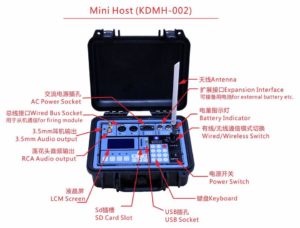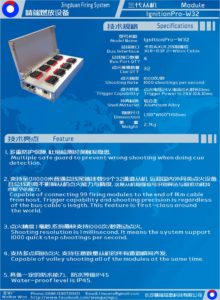To create and export a script for the Jingduan firing system, please follow these steps:
- Address the show (“Addressing > Address show”).
- Export the script (“File > Export > Export firing scripts“).
Step 2 creates the script file, which is a standard format CSV file with a “CSV” extension.
Please note: older versions of the Jingduan firing system do not support CSV script files. Please contact your Jingduan dealer to upgrade to a version that supports CSV files.

Figure 1 – Jingduan firing system
Table 1 – File format and encoding
| File format | Extension | Text encoding | Field delimiter | End-of-line |
|---|---|---|---|---|
| Text | .CSV | UTF-8 | Comma | CRLF |
The script contains rows for the firing events, i.e., unique combinations of module, pin, and ignition-time. Multiple effects can be combined on a single cue. The special characteristics of the script are shown in the following table:
Table 2 – Special characteristics
| Special characteristics | Description |
|---|---|
| Sort order of rows | Rows sorted ascending by event time, then by module number, then by pin number. |
| What rows represent | Each row represents a unique firing event, a module/pin/event-time combination. For example, a chain of five shells will be one row, not five. A pair of shells shot together from the same position will be one row, not two, even if the shells are different effects. A flight of shells shot together from multiple positions with the same module-pin using scab wire is still one row. |
| Header | The file contains a single header row with the column names: Ignition Event Time,Prefire Delay,Host Address,Module Address,Pin Address,Effect Name,Caliber,Category,Angles,Position Name. |
| Addresses | The Jingduan system addresses are Host (1-99), Module (1-99), and Pin (1-32). |
| Time resolution | Millisecond resolution. |
| Host | The Jingduan system supports multiple controllers (“Hosts”) represented in the same firing system script. In Finale 3D, the “Universe” column in the script and in position properties partitions the show into multiple controllers, so the Universe column is the most natural column in Finale 3D to hold the Host number. For most firing systems, when Finale 3D exports the script files for the show it exports a separate script file for each unique Universe, but for the Jingduan firing system Finale 3D exports a single script file that combines all the Universes; and in that script file the Host column contains the Universe values.
To create a show for multiple hosts, 1) Right click on the launch positions and edit “Position properties” from the context menu, 2) In the Position Properties dialog, type the Host number into the Universe column, 3) Re-address the show from Addressing menu, which will assign module and pin addresses and additionally will copy the Universe values from the positions into the script, 4) Export the script from the File menu. |
| Special characters | The CSV file follows Excel rules for quoting double quotes and commas within the fields. Except for those two characters, all other printable UTF-8 characters are allowed. Unprintable characters (control characters like linefeed and tab) are filtered out. |
After the header, each row in the script has a number of fields separated by the comma character. If any field contains a comma or double quote character, the field will be surrounded in double quotes and any internal double quotes will be doubled-up, following the Excel CSV convention. The names of the fields and their descriptions are the following:
Table 3 – Specifications of script fields
| Field name | Description |
|---|---|
| Ignition Event Time | The launch time of the event; floating point number with up to millisecond resolution. |
| Prefire Delay | The prefire time of the effect; floating point number with up to millisecond resolution. |
| Host Address | Host number, starting with 1. The host identifies the controller. This number comes from the Universe field in Finale 3D. |
| Module Address | Module number, starting with 1. |
| Pin Address | Pin number, starting with 1. |
| Track Identifier | Track number or blank. |
| Effect Name | Description. If the row represents multiple effects, the description begins with the number of effects in parentheses, continues with the first effect name, and ends with elipsis (…) as an indication the row represents more than is being displayed in this single field. |
| Caliber | Size. |
| Category | The Type of the effect in Finale 3D, or blank. |
| Angles | Angle graphic in ASCII art, showing the angles of the represented effects in backslash, vertical line, and slash characters. |
| Position Name | Position name. |
An example script containing nine shells across nine firing rows is shown in Figure 1 and included for download in Table 4.
Ignition Event Time,Prefire Delay,Host Address,Module Address,Pin Address,Track Identifier,Effect Name,Caliber,Category,Angles,Position Name
2.76,2.24,1,1,1,,Red Chrysanthemum,"2""",shell,|,Pos-01
3.344,2.24,1,2,1,,Red Chrysanthemum,"2""",shell,|,Pos-02
3.928,2.24,1,3,1,,Red Chrysanthemum,"2""",shell,|,Pos-03
4.512,2.24,1,4,1,,Red Chrysanthemum,"2""",shell,|,Pos-04
5.096,2.24,1,5,1,,Red Chrysanthemum,"2""",shell,|,Pos-05
5.68,2.24,2,1,1,,Red Chrysanthemum,"2""",shell,|,Pos-06
6.264,2.24,2,2,1,,Red Chrysanthemum,"2""",shell,|,Pos-07
6.848,2.24,2,3,1,,Red Chrysanthemum,"2""",shell,|,Pos-08
7.432,2.24,2,4,1,,Red Chrysanthemum,"2""",shell,|,Pos-09
Figure 1 – Example Jingduan script with two universes — Host 1 and 2
Table 4 – Example files
| Download link | Explanation |
| test-jingduan.fin | Example show file |
| test-jingduan.csv | Example exported file (CSV) |
 |
Data sheet |